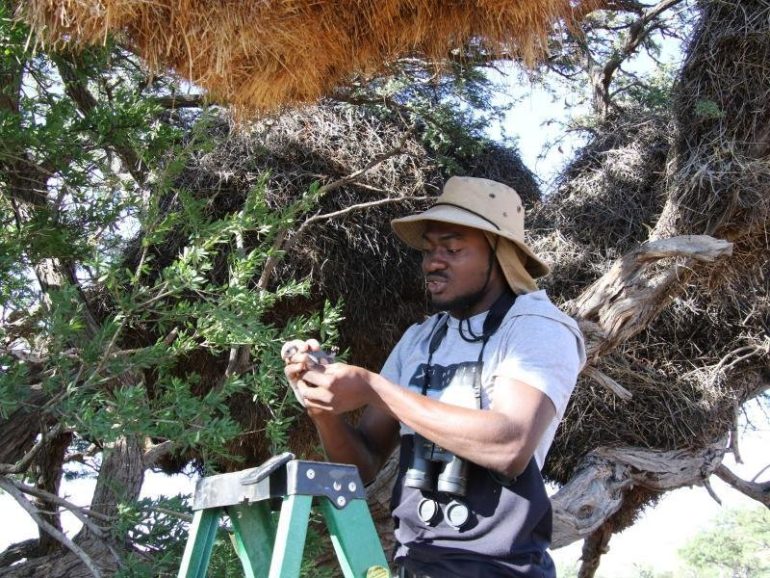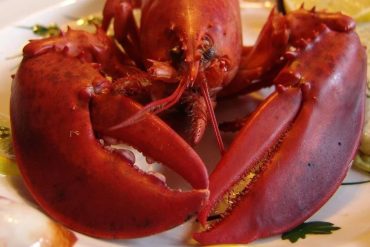CURUMAN, South Africa (AP) – Thousands of cicadas give a deafening concert. The sun burns on the rust-red sand from a cloudless sky. Rain is considered a boon in this part of the world. Only the most resilient can survive, be it plants or animals.
In the scorching heat, Olufemi Olubodun (30) examines the nests of the settlers. The birds that breed in colonies nestle around the branches of an acacia tree with blades of grass like three giant bunches of grapes. The large-scale habitat consists of a dozen interwoven breeding chambers, which keep the interior of the community’s nest cool despite the high outside temperatures. In Kalahari, these can often exceed 40 °C.
Olubodon oversees a brood chamber in which a pair of mink falcons have taken up residence with the colony’s breeders. Small birds of prey help protect the nest from hungry snakes, but they are also an enemy that kills weaver’s offspring. Olubodun carefully picks up the hawk chicks one after the other from the nest. They are measured, weighed and ringed. He follows how birds develop despite extreme temperatures and prolonged droughts.
Olubodun’s research is part of a larger study at the University of Cape Town’s Department of Life Sciences (UCT). The Kalahari Threatened Ecosystem Project (KEEP) brings together scientists from several universities at the Dedeben Research Center in the South African Tswalu Nature Reserve, a few kilometers south of Botswana.
Ideal place for researchers
Above all, they want to research one thing: how the world changes when the Earth warms by 1.5 degrees – a temperature rise that, according to the UN’s Paris Agreement, should not be exceeded. The Kalahari, consisting of desert and savannah, which stretches about one million square kilometers through Namibia, South Africa and Botswana and is already considered a climate change hotspot, is the ideal location for it.
It is hotter and drier in the Kalahari than in many parts of the world. Animals and plants have to adapt to rising temperatures and decreasing rainfall in order to survive, including many threatened species. According to the South African Meteorological Service, temperatures in parts of southern Africa have risen twice as fast as the global average over the past 50 years. The researchers estimate that the average temperature in the Kalahari would increase by 2.2 °C if the world increased by 1.5 °C. It means: The Kalahari gives climate researchers an extraordinary window into the future from which the rest of the world can draw important conclusions.
KEEP not only examines individual animal and plant species, but also seeks to provide an overview of the entire food chain: from grasses to insects, from birds and reptiles to mammals. Who influences whom? Who is dependent on whom and what are the consequences? The researchers want to identify key species that are indispensable to the food chain and therefore require special protection to protect the entire ecosystem. “We are concerned with the domino effect that begins when a link in the chain is affected by climate change,” explains Dylan Smith, director of Tsvalu research.
The project, which started in 2019, is still in its infancy. Scientists need data sets over many years, if not decades, to be able to make reliable statements. Nevertheless, there are already effective indicators, especially from researchers who had already started their study before the KEEP project, Smith explains: “we are certainly seeing earlier behavioral patterns”.
Severe drought has very specific consequences
Two severe droughts in 2015 and 2019 were good indicators of the potential impacts of climate change. For example, there was a decrease in grass growth during that period, explains KEEP project manager Wendy Panano. As a result, there were fewer termites that require grass to survive. This in turn affects animals that eat termites, such as pangolins classified as threatened on the ICUN Red List.
Pangolin saw a sharp decline during two periods of drought in Panano. Many other animals also died or died of starvation. “Kalahari animals have already adapted to extreme weather conditions. Now it is getting even hotter and drier. This begs the question: when will the limit be reached? Panino asks.
The African wild dog, which is considered endangered in South Africa with an estimated 500 specimens, is also affected. Animal welfare physiologist Kefon Jumbum, a postdoctoral fellow at the University of the Witwatersrand in Johannesburg, sees a small pack with temperature-measuring devices implanted in Tsvalu. According to Jumbam, the body temperature of wild dogs reaches around 40 degrees Celsius on hot days. “Animals eat less because hunting prey will raise their body temperature even more,” she explains. The window of time in which the prey is cold enough to hunt is also becoming increasingly smaller. Jumbam fears that it is slowly but surely causing a decline in the number of animals.
Step by step, researchers from the KEEP project put together the pieces of the puzzle that should allow them to observe the Kalahari’s entire ecosystem. The work is slow and difficult, but Panano is certain: “Our results will be relevant to ecosystems around the world.”

Web guru. Amateur thinker. Unapologetic problem solver. Zombie expert. Hipster-friendly travel geek. Social mediaholic.





